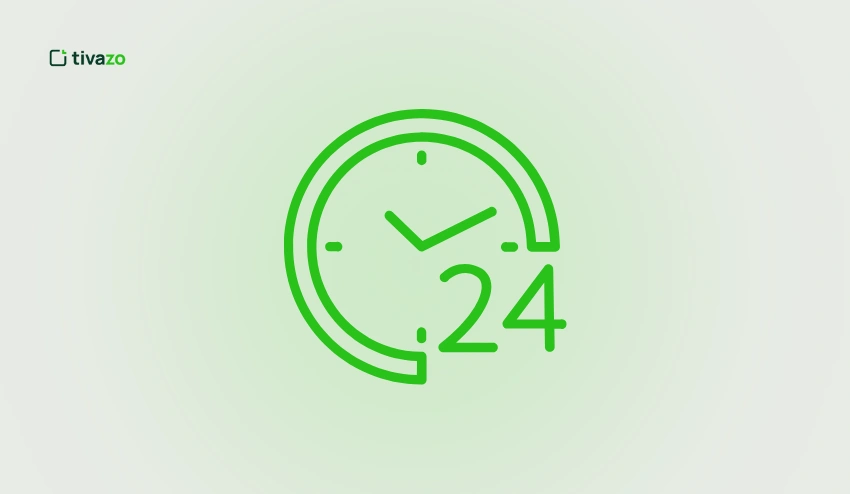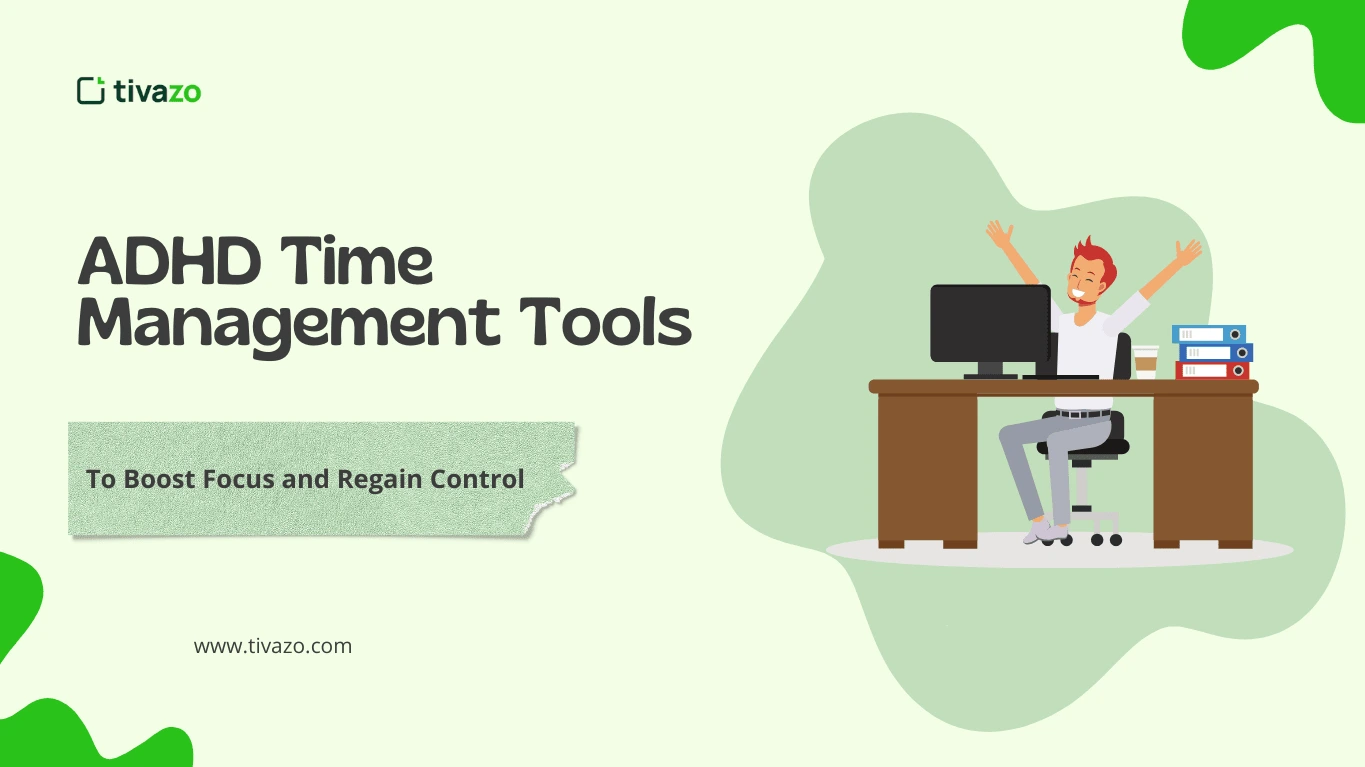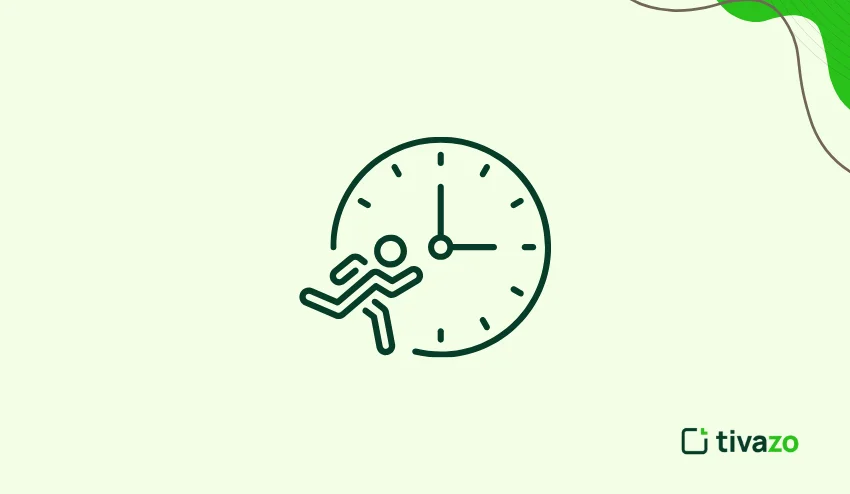Time boxing not only assists with task management and scheduling, but it also allows you to train your brain to concentrate on one task at a time. Placing limits on how much time you can spend on tasks helps to limit perfectionism and overthinking. Both are productivity killers. It also encourages a little urgency, which makes it easier to get started on tasks vs. procrastinate. Time boxing is flexible for personal use as well as work use. You can use it to manage small everyday chores or even complex projects at work.
Over time, it helps you to build discipline, be more accurate when estimating time, and gives you structure for your day-to-day activities to lead to greater results consistently, as well as improve the work/life balance ratio.
Time Boxing Overview
Time boxing is a tool where you select a set time to complete a task. Instead of working on a to-do item and scraping it out when it is “done,” you take a block of time ranging from 15 minutes to several hours to complete a task. You only want to focus on completing your task within the time frame you set out.
Essential Characteristics of Time Boxing:
- Tasks have fixed start and end times
- Will encourage sustained but focused work while eliminating distractions
- Provides the ability to manage the workload.
- User Search Intent: Informational
What is Time Boxing?
Time boxing is straightforward, yet extremely effective:
- Identify Tasks: Write down all the tasks that need to be done.
- Set Time Blocks: Assign a fixed amount of time to each task.
- Set Deadlines: All blocks should have a clearly defined start and end. Focus During Time Box: Do only the task at hand. Review and Adjust: Evaluate your productivity at the end of the time block.
This method prevents you from spending too much time on lower-priority tasks and encourages you to progress without burning out.
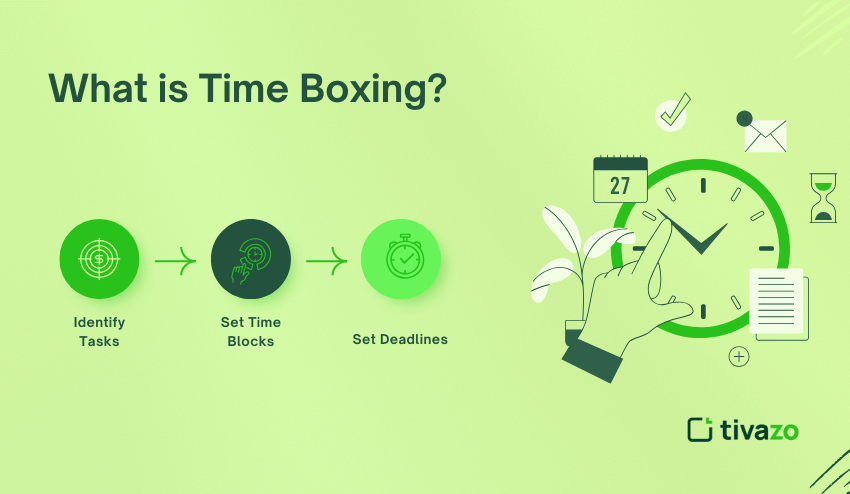
In addition to avoiding the downsides of overworking on tasks, time boxing encourages intentionality around planning and prioritization of work. By separating all the tasks to be done and blocking specific amounts of time for each task, you can get a clear understanding of what you can accomplish in a day. Ultimately, blocking time for specific tasks helps reduce stress because you have better assurance that you are not going to spend an infinite amount of time on a task. It also helps you better track your productivity because you can measure productivity against your scheduled blocks.
Over time, you will likely get more disciplined in the work habits you form as you practice boxing. You will also become better at estimating how much time it takes to do a specific task. Over time, the Time Box method also naturally supports flexibility in your work because if you did not finish the work, you just move the work to your next available time box. You can approach your tasks in an organized, manageable way.
How do I begin time boxing?
When it comes to beginning time boxing, it’s not simply a matter of choosing a period of time; you are establishing an organized way of working that maximizes focus and productivity.
Step 1: Choose Your Tasks
Begin your time boxing journey by compiling a list of tasks that need to be completed. If you are working on a larger task, try to break it down into manageable, smaller tasks. Determine the order of tasks based on deadlines and importance so you can complete your highest priority work first.
Step 2: Identify Your Time Blocks
Determine a realistic time allocation for each task. As a new time boxer, you should try working in time blocks of 30-60 minutes and adjust your future sessions based on an understanding of your focus tolerance. Do not set yourself up for failure by overestimating or underestimating; both can be productivity killers.
Step 3: Schedule Your Time Blocks
Visual is important in this step. When you are in the process of time boxing, the use of calendars, digital planners, or apps like Google Calendar or Trello will help schedule each time block. Seeing your day mapped out helps build accountability and prevents over-committing to your work tasks.
Step 4: Remove distractions
After selecting your tasks and setting your time blocks, every effort should be made to create a focused workspace. Silence your notifications, close tabs in your web browser that are not related to your work, and let the people you work with know you are unavailable. You are committed now to using your time block wholeheartedly toward accomplishing the labelled task.
Step 5: Evaluate the results
After each time box session, you should evaluate how your session went. Things to note are what went well and what could have gone better. Utilizing the evaluations from each session will help you determine if you need to adjust your time allocations and/or the sequence of your time boxing process in order to improve workflow and overall productivity.
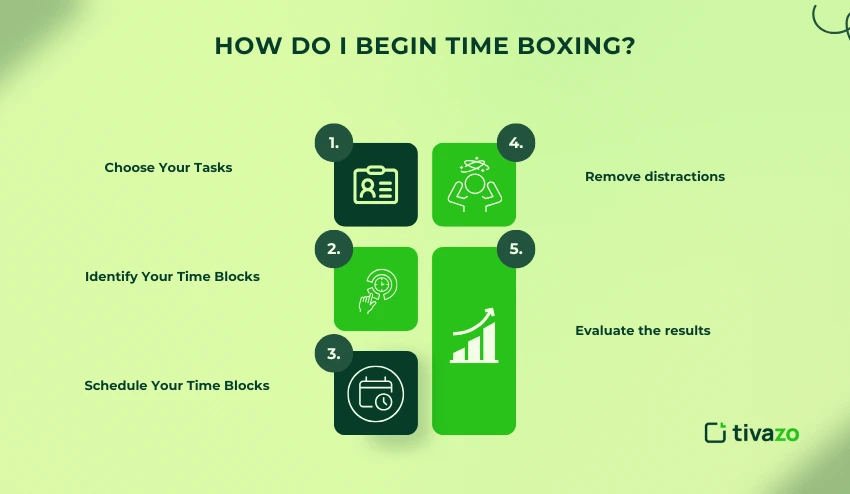
Key Strategies for Time Boxing
To make time boxing an effective approach to improving productivity and time management, it is essential to introduce key strategies that allow for greater focus and overall productivity:
1. Set realistic durations
The use of time is incredibly important. On one end of the spectrum, you can set too short of time blocks—it will generate stress and create unfinished work. On the other side, you can set too long a time block—it will lead to fatigue and wasted time. Start with using the right amount of time and test out different time boxes to find when your focus allows you to be productive, or adjust based on the complexity of the tasks required (creative work will probably require longer time boxes, routine tasks can be shorter).
2. Use the Pomodoro technique
You can also pair time boxing with the Pomodoro technique to help increase your focus. Time boxing generally uses concentrated work blocks of 25–30 minutes, then a 5-minute break to prevent burnout, and it refreshes your mind while allowing you to keep high productivity levels throughout the day.
3. Prioritize high-impact tasks
Not all tasks have the same impact and value. Use your prime focus time (when your energy levels and alertness are at a peak) to complete activities that will have the most impact on your goal. Low-priority low-impact tasks can fill in short time boxes when you are less energetic or productive, so you can complete other activities with higher priority. Prioritizing your tasks ensures your most important work receives the time and attention it deserves.
4. Allow for Unplanned Work
Even the best-laid plans can be interrupted by Indispensable work or urgent tasks. Build in tiny buffer times between your time blocks so that these can fit without messing up your schedule. This allowance for unplanned work supports you in keeping on track and reduces stress from his unforeseen interruptions.
5. Evaluate
At the end of each day or week, look back at all of your completed time blocks. Record the blocks you got the most done, and some of the blocks that time never allowed you to finish. Evaluating allows you to tune up those future time blocks, giving you a more effective and tailored time boxing mechanic according to the flow of your action.
After applying these actionables, time boxing is more than a method of scheduling; it gives a method of organization that adds structure to your focus, efficiency, and productivity.
When utilizing those practices, it shifts time boxing beyond the scheduling and planning tool it typically functions more commonly as, into a process that helps support your focus, efficiency, and productivity.
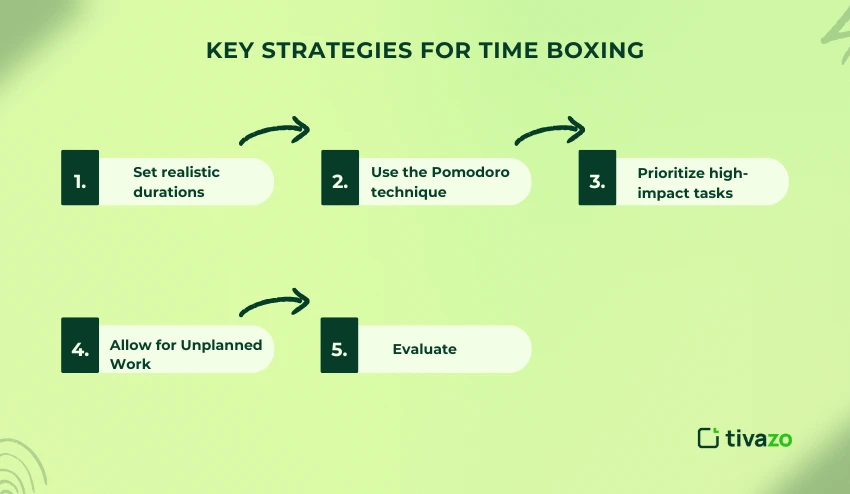
Daily Time Boxing Example
| Time Block | Task | Duration | Notes |
| 8:00 AM – 9:00 AM | eMail responses | 60 Only | Focus on emails |
| 9:00 AM – 10:30 AM | Project work | 90 min | High-priority task |
| 10:30 AM – 10:45 AM | Break | 15 min | Refresh and reset |
| 10:45 AM – 12:00 PM | Meeting preparation | 75 min | Use focused deep work |
| 1:00 PM – 2:30 PM | The client calls | 90 min | Batch calls together |
| 2:30 PM – 3:00 PM | Review/planning | 30 min | Adjust blocks for the following day. |
How to Share Your Time Blocks with Others
For distributed teams, time boxing is only as powerful as everyone else respecting those blocks.
- Shared Calendars: Advise teammates when you are focused.
- Set Boundaries: Allow no interruptions during blocks unless it is an emergency.
- Status Tools: Mark as busy on Slack or Teams.
- Team Syncs: Schedule collaborative work outside your focus blocks.
What Are the Advantages of Time Boxing?
Time boxing has a host of benefits that make it a very useful productivity tool:
- Improved Focus: The dedicated nature of allotted periods makes multitasking less likely, since you are completely focused on a single task for that time duration.
- Improved Productivity: Time frames encourage you to limit time spent working on tasks to specific periods in which you can complete tasks efficiently, since you cannot waste time on overthinking or parsing minutiae to satisfy perfectionism.
- Improved Planning: Your day can be effectively structured around time blocks, reminding you of what you can practically get done and when.
- Less Procrastination: With set start and end times, there is a bit of urgency, which can push you to start tasks without delay.
- Work-life balance: Structured work means that you can work in a focused manner to be less likely to burn out and have to respect personal time and breaks.
Time boxing can also help with accountability. When you think about the periods you are allotting to tasks, you usually want to know how you are progressing, and can work on the quality of your work (or not) by critiquing your performance. This is ultimately a process that, over the long term, can help you to make your time estimates more accurate, have better discipline, and provide a sense of accomplishment at the end of the day. When used thoughtfully, time boxing can reduce decision fatigue and wasted time, thus providing workflow efficiencies that can help you complete tasks faster while maintaining mental energy and clarity.
Is Time Boxing Useful?
Research and experience have demonstrated that time boxing brings more focus, efficiency, and task completion. Many successful people, like Elon Musk, utilize some version of time boxing to keep their schedules in check, implying a relative level of effectiveness in the professional world.
Additional Effectiveness Facts:
- Fosters disciplined work habits by providing time blocks.
- Mitigates decision fatigue by defining when to work on what.
- Assists with time estimation skills by practicing and reviewing them.
- Prevents distractions by devoting blocks of time to a focused effort.
- Allows for measurable progress with both short-term and long-term objectives.
Time boxing is effective for both individuals and teams trying to boost productivity and have some level of balance and control over their daily schedules.
Time Boxing Implementation Tools
| Tool | Action | Who |
| Google Calendar | Block time | Individuals & Teams |
| Trello | Visual task management | Project-based work initiatives |
| Notion | Task Planning and Documentation | Knowledge Workers |
| Toggl Plan | Planning + Time tracking | Freelancers & Small Teams |
Common Time Boxing Errors
- Overloading the Tasks: Do not stack all of your blocks back to back.
- Ignoring breaks: Keep yourself on a regular break pattern to help stay on track.
- Being too rigid: If something takes more or less time than expected, adjust your blocks when possible.
- Skipping planning: Failing to communicate within and out of teams: Having visibility over timelines allows teams or individuals to respect time blocks.
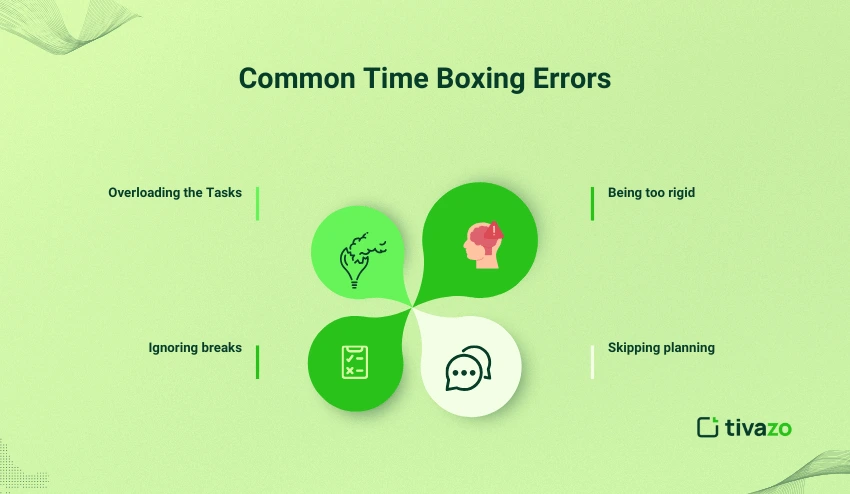
Advanced Time Boxing Strategies
- Pair your time boxing with priority matrices in order to focus your energies on the work that presents the biggest impact.
- Review your work weekly to see where you can adjust for recurring patterns and/or bottlenecks.
- Pair with task batching when tasks are repetitive or similar.
- Utilize a digital visual timer or app to reinforce strict start and stop times.
Conclusion
Time boxing is a potent time management model that amplifies focus, efficiency, and productivity in tasks you need to accomplish. It is based on the principle of planning fixed blocks of time to complete a task and, therefore, the ability to eliminate distractions, overcome procrastination, and allow you to manage a better work-life balance. Time boxing is an adaptable model, endorsed by productivity experts from various fields, and used by high-performing professionals such as Elon Musk.
To get started with time boxing, follow these steps: Decide what task needs to be accomplished, identify the time blocks to complete each task, and review your results and performance. After several months of consistently boxing your work, you should see a noticeable increase in your productivity as well as your ability to complete and oftentimes exceed deadlines.

